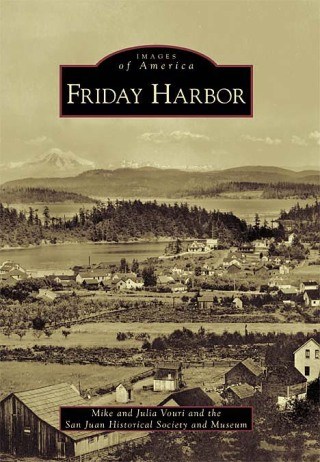“Friday Harbor” by Mike and Julia Vouri and the San Juan Historical Society tells a unique and richly detailed story about this historic seaside village, which is celebrating its centennial this year. And it’s an entertaining read.
The book is published by Arcadia Publishing Co. as part of its Images of America series and is available now at local bookstores and at the historical museum. Also available is a pack of postcards featuring photos from the book.
Museum director Kevin Loftus said he took the proofs to bed for some nighttime reading, about 10 p.m., one night, expecting to do a quick review before getting some shuteye. He was still reading at 12:30 a.m.
“It’s a page turner,” Loftus said.
Indeed. This is a book you can sit down with and enjoy in one evening. It consists of more than 200 photos — many of them never before seen or published — depicting Friday Harbor’s First Peoples, the building of the community, civic events, schools, town industries, and the people who shaped the community.
The book’s foreword was written by Dr. David Kennedy, Pulitzer Prize-winning historian (“Freedom From Fear: The American People in Depression and War, 1929-1945”) and Stanford University history professor.
This is the fourth book for Mike Vouri and the first for his wife, Julia, and the San Juan Historical Society. Most of the images in this volume were selected from the society’s collection of nearly 2,000 historic photographs. Royalties from the book will support restoration and maintenance of the San Juan Historical Museum’s buildings.
Mike Vouri is the author of “The Pig War” (Arcadia Publishing Co., 2008); “Outpost Of Empire: The Royal Marines And The Joint Occupation Of San Juan Island” (Northwest Interpretive Association, 2005); and “The Pig War: Standoff at Griffin Bay” (Griffin Bay Bookstore, 1999). Julia Vouri has been a writer and editor specializing in travel and health for 30 years.
“It was a great experience from beginning to end,” Mike Vouri said of “Friday Harbor.” “Our editor at Arcadia, Sarah Higginbotham, was wonderful and kept us on task. You can’t just sit down and do a book like this. You have to be organized. And you can’t write everything. The photographs have to relate together and tell the story.”
Farming, salmon fishing and timber fueled Friday Harbor’s early economy. However, by mid-century, the lumber mill was gone, the introduction of irrigation in Central Washington swamped fresh produce markets, and the fish and pea canneries were shut down. Life slowed and some left, but in being passed by — until tourism caught on in the late 1970s — the town (and island) developed a unique sense of community that survives to this day.
You’ll see the evolution of Spring Street over the years. You’ll see how buildings and houses were moved — often — in a community that put as much value in resources as it did hard work.
You’ll meet characters like Harry Wilks, who Vouri calls an “artist with dynamite,” who was once hired to blast rock from beneath a house on Harrison Street to make room for a basement. He accomplished the job without so much as a crack in the plaster.
You’ll meet entrepreneurs like merchant L.B. Carter, who lent the money to keep San Juan County Bank afloat during the Great Depression, but did it on a handshake because he didn’t want his children to think he risked their inheritance.
You’ll learn little-known facts. A rare photo of saloon keeper Jack Douglas’ home on lower Spring Street is believed to have originated at American Camp. The house’s fate is a mystery.
You’ll see some common threads that bind the generations of residents. “When things were tough, people banded together,” Loftus said. “They had a different view of life, that one person can make a difference in the community. That sense of community resonates today.”
Vouri said islands are a logical extension of the American frontier. Out here, surrounded by water, we’re essentially on a boat at sea. We stick together, or we sink together, he said.
Speaking of boats at sea, you’ll see how important water transportation has always been for islanders — from the age of the canoe to the mosquito fleet to the state ferries. “It underscores how important the ferries are for the island and why we struggle to get a fair shake,” Vouri said.
Jim Cahail, a lifelong Friday Harbor resident and former mayor who assisted the Vouris, said of the book, “It was kind of neat to go back and look at the old pictures. It was kind of a trip down memory lane for me. There are a lot of things in the book that a lot of people don’t know.”
He added, “The way Mike and Julia put it together — they tried to take each decade, go through the history of the town, dig into why this building was this building and why these people were prominent in the community.”
“Friday Harbor” is entertaining and at times humorous. It is an important record that will be a useful resource for historians as well as prized by generations to come.
Leading history publisher
Arcadia Publishing is the leading local history publisher in the United States, with a catalog of more than 4,000 titles in print and hundreds of new titles released every year.
Arcadia is best known for its Images of America series, which chronicles the history of communities from coast to coast. With more than 200 vintage black-and-white photographs, each title celebrates a town or region, bringing to life the people, places and events that define the community.
The New York Times wrote of the Images of America series, “For readers with a more localized interest in history that can generally be satisfied in the classroom or the best-seller bin, the Images of America books are an invaluable resource.”




